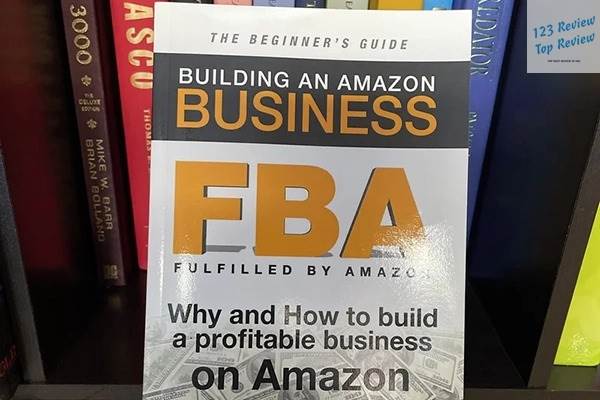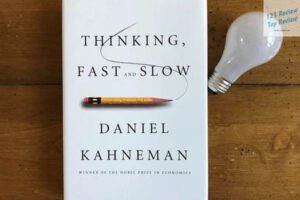Amazon, the global e-commerce giant, serves as a marketplace for millions of sellers, making the competition fierce. However, Cusack’s “Building an Amazon Business” breaks down the complexities of the Amazon ecosystem into manageable strategies, focusing on key aspects such as economic feasibility, product selection, financial planning, and growth tactics.
In this article, 123 Review is not just about starting a business but about building a sustainable and profitable one.
Key Strategies for Success
Economic Feasibility Analysis
One of the foundational steps emphasized by Ged Cusack is conducting a thorough economic feasibility analysis before diving into the Amazon marketplace. This involves assessing whether your business idea is economically viable in the long term. Cusack guides readers through evaluating the initial capital requirements, understanding ongoing costs, and projecting potential revenues.

The process begins with understanding market demand. Cusack explains how to gauge demand for your product by analyzing search volume on Amazon, studying consumer behavior, and utilizing tools like Google Trends. He also delves into competitive analysis, helping readers identify the level of competition and determine whether entering the market would be profitable.
Profit margin analysis is another critical aspect of feasibility. Cusack stresses the importance of calculating all costs involved—from manufacturing and shipping to Amazon’s fees—and determining the price point that allows for a healthy profit margin. He also covers how to estimate the return on investment (ROI) over time, ensuring that your business is not just sustainable but also capable of growth.
Product Selection and Market Research
Product selection is arguably the most crucial decision in building a successful Amazon business. Cusack dedicates significant attention to this process, offering a detailed methodology for identifying products that have the potential to succeed. The key is finding the sweet spot between high demand and low competition.
Cusack walks readers through the process of market research, starting with identifying broad categories of interest. He then drills down into specific niches, using Amazon’s Best Sellers list, customer reviews, and competitor analysis as tools to uncover product opportunities. The goal is to identify products that solve a problem or fulfill a need that is not being adequately met by current offerings.
The book also discusses the importance of understanding the lifecycle of a product. Cusack advises entrepreneurs to consider whether the product is a fad, seasonal, or evergreen. He provides strategies for capitalizing on short-term trends while also building a portfolio of products with long-term potential. This dual approach helps mitigate risks and ensures a steady stream of revenue.
Optimizing Product Listings
After selecting the right products, the next step is optimizing your product listings to maximize visibility and conversion rates. Cusack provides a comprehensive guide to creating compelling listings that not only attract potential customers but also persuade them to buy.
The optimization process begins with the product title. Cusack emphasizes the importance of crafting a title that includes relevant keywords while being descriptive and appealing to shoppers. He explains how Amazon’s search algorithm works and how keywords should be strategically placed in the title to improve search ranking.
Product descriptions are equally important. Cusack offers tips on writing detailed, benefits-focused descriptions that address customer pain points and highlight the unique selling propositions of your product. He also discusses the role of bullet points in making key features easily scannable, which is crucial for mobile shoppers.
Images are another critical component of a successful listing. Cusack advises on selecting high-quality images that show the product from multiple angles and in use. He also discusses the potential benefits of including lifestyle images and videos to give customers a better sense of the product’s value.
Finally, Cusack delves into the importance of customer reviews and ratings. He provides strategies for encouraging positive reviews and handling negative feedback in a way that builds trust with potential buyers. The combination of optimized titles, descriptions, images, and reviews creates a powerful listing that can drive significant sales.
Leveraging Amazon’s Promotional Tools
Amazon provides a variety of promotional tools that can help sellers boost their visibility and drive sales. Cusack covers these tools in detail, explaining how to use them effectively to achieve your business goals.
Sponsored Products is one of the most popular promotional tools on Amazon. Cusack explains how to set up and manage Sponsored Products campaigns, including tips on keyword selection, bidding strategies, and budget management. He also discusses how to track campaign performance and adjust your strategy based on the results.
Lightning Deals and Amazon Coupons are other powerful promotional tools. Cusack provides insights into the best times to run these promotions and how to use them to clear out inventory, launch new products, or boost sales during peak seasons. He also discusses the pros and cons of each tool and offers advice on how to maximize their effectiveness.
Cusack emphasizes the importance of strategic planning when using Amazon’s promotional tools. He advises setting clear objectives for each promotion and carefully tracking the results to ensure a positive return on investment. By leveraging these tools effectively, sellers can significantly increase their product’s exposure and drive more sales.
Financial Planning
Initial Investment Requirements
Financial planning is a critical component of building a successful Amazon business. Cusack provides a detailed overview of the initial investment requirements, helping readers understand the costs involved in starting and scaling an Amazon business.
The first step is understanding the various costs associated with launching an Amazon business. Cusack breaks down these costs into several categories, including inventory, Amazon seller fees, and marketing expenses. He explains how to estimate the amount of capital needed to cover these initial costs and provides tips for minimizing expenses without compromising on quality.
Cusack also discusses different financing options available to entrepreneurs, such as personal savings, loans, and investors. He provides advice on how to raise capital if necessary and the pros and cons of each financing method. This section is particularly valuable for those who may not have significant upfront capital and are looking for ways to fund their business.
Budgeting for Inventory and Logistics
Effective budgeting for inventory and logistics is crucial for maintaining profitability and ensuring smooth operations. Cusack provides a detailed guide to budgeting for these aspects of your business, helping you avoid common pitfalls that can lead to cash flow problems.
Inventory management is a key focus in this section. Cusack discusses how to calculate the optimal amount of inventory to hold, taking into account factors like lead time, demand fluctuations, and storage costs. He explains the importance of maintaining a balance between having enough stock to meet demand and avoiding excess inventory that ties up capital.
Logistics is another critical area covered in this section. Cusack provides insights into the costs associated with shipping, including freight costs, customs duties, and Amazon’s Fulfillment by Amazon (FBA) fees. He advises on how to choose the most cost-effective shipping methods and how to budget for these expenses.
Cusack also discusses the importance of forecasting and planning for future inventory needs. He provides tips on how to use sales data and market trends to make informed decisions about when to reorder inventory and how much to order. This proactive approach to inventory management can help you avoid stockouts and ensure that you always have the right amount of inventory on hand.
Managing Fees and Expenses
Amazon’s fee structure can be complex, and managing these fees is essential for maintaining healthy profit margins. Cusack provides a comprehensive overview of the various fees that Amazon sellers need to be aware of and offers strategies for minimizing these costs.
The main fees that sellers need to consider include referral fees, fulfillment fees, and storage fees. Cusack explains how each of these fees is calculated and how they impact your overall profitability. He also provides tips on how to factor these fees into your pricing strategy to ensure that you are still making a profit after all expenses are accounted for.
In addition to Amazon’s fees, Cusack discusses other expenses that sellers need to manage, such as advertising costs, shipping costs, and returns. He advises on how to track these expenses and identify areas where costs can be reduced without compromising the quality of your products or services.
Cusack also provides insights into how to optimize your business processes to reduce unnecessary expenses. For example, he discusses how to manage inventory turnover rates to minimize storage fees and how to choose the most cost-effective shipping options. By carefully managing fees and expenses, sellers can improve their profit margins and ensure the long-term success of their Amazon business.
Operational Aspects
Handling Logistics and Supply Chain
Effective logistics and supply chain management are crucial for ensuring that your products reach customers on time and in good condition. Cusack provides a comprehensive guide to managing these aspects of your business, helping you build a reliable and efficient supply chain.
The first step is sourcing products from reliable suppliers. Cusack offers tips on how to find and vet suppliers, including how to negotiate favorable terms and ensure that the products meet your quality standards. He also discusses the importance of building strong relationships with your suppliers to ensure that they are willing to work with you as your business grows.
Cusack also covers the logistics of shipping products from your suppliers to Amazon’s fulfillment centers or directly to customers. He provides advice on how to choose the best shipping methods, taking into account factors like cost, speed, and reliability. He also discusses the pros and cons of using Amazon’s Fulfillment by Amazon (FBA) service versus handling fulfillment in-house.
Another important aspect of logistics is managing customs and import regulations. Cusack provides guidance on how to navigate these complexities, including how to calculate duties and taxes, and how to ensure that your products comply with all relevant regulations. This is particularly important for sellers who are sourcing products from overseas suppliers.
Cusack also discusses the importance of supply chain resilience. He advises on how to build a supply chain that can withstand disruptions, such as supplier issues or shipping delays, by diversifying your supplier base and having contingency plans in place. This proactive approach can help you avoid costly delays and ensure that your products are always available for sale.
Customer Service and Feedback Management
Customer service is a critical component of maintaining a positive reputation on Amazon. Cusack emphasizes the importance of providing excellent customer service, as it directly impacts your seller rating and, ultimately, your sales performance.
Cusack begins by discussing the importance of timely and professional communication with customers. He provides tips on how to respond to customer inquiries, handle returns and refunds, and resolve any issues that arise. He also discusses the importance of setting clear expectations with customers regarding shipping times, product descriptions, and return policies.
Feedback management is another key area covered in this section. Cusack explains how to encourage satisfied customers to leave positive reviews and how to address negative feedback in a way that demonstrates your commitment to customer satisfaction. He provides strategies for proactively managing your feedback score, including how to handle situations where a customer leaves a negative review that you believe is unjustified.
Cusack also discusses the importance of using customer feedback to improve your products and services. He advises on how to analyze feedback to identify common issues or areas for improvement, and how to implement changes that will enhance the customer experience. By focusing on customer service and feedback management, sellers can build a loyal customer base and improve their standing on Amazon.
Inventory Management Techniques
Effective inventory management is crucial for ensuring that you always have the right amount of stock on hand to meet customer demand. Cusack provides a detailed guide to inventory management, helping you avoid common pitfalls like stockouts and overstocking.
Cusack begins by discussing the importance of demand forecasting. He provides tips on how to use sales data, market trends, and seasonal patterns to predict future demand for your products. He also discusses how to account for lead times and shipping delays when planning your inventory levels.
Another key aspect of inventory management is optimizing your reorder points and quantities. Cusack explains how to calculate the optimal reorder point for each product, taking into account factors like sales velocity, lead time, and safety stock. He also provides guidance on how to determine the optimal reorder quantity to minimize carrying costs while ensuring that you have enough stock to meet demand.
Cusack also covers the use of inventory management software to automate and streamline the inventory management process. He provides an overview of the different types of software available and their key features, such as inventory tracking, reorder alerts, and demand forecasting. By using the right tools, sellers can improve their inventory management efficiency and reduce the risk of stockouts or overstocking.
Finally, Cusack discusses the importance of regular inventory audits. He advises on how to conduct physical inventory counts, reconcile discrepancies, and identify any issues with your inventory management process. Regular audits can help you catch and correct errors before they lead to costly problems, such as stockouts or lost sales.
Growth and Expansion
Strategies for Scaling Your Business
Scaling an Amazon business requires careful planning and execution. Cusack provides a comprehensive guide to scaling your business, helping you increase sales volume, expand your product line, and improve operational efficiency.
The first step in scaling your business is reinvesting profits into growth. Cusack advises on how to allocate profits to purchase more inventory, invest in marketing, and develop new products. He also discusses the importance of maintaining a healthy cash flow to ensure that you have the funds needed to support your growth efforts.
Cusack also covers the importance of expanding into international markets. He provides tips on how to research and enter new markets, taking into account factors like local demand, competition, and regulatory requirements. He also discusses the logistics of selling internationally, including how to manage shipping, customs, and taxes.
Automation is another key aspect of scaling your business. Cusack provides insights into how to automate various aspects of your business, such as order fulfillment, inventory management, and customer service. By automating these processes, you can free up time and resources to focus on strategic growth initiatives.
Finally, Cusack discusses the importance of building a strong brand. He advises on how to create a brand that resonates with your target audience and stands out in the competitive Amazon marketplace. He also provides tips on how to use branding to increase customer loyalty and drive repeat business.
Exploring New Product Categories
As your Amazon business grows, expanding into new product categories can offer opportunities for diversification and increased revenue. Cusack provides a detailed guide to exploring new product categories, helping you identify and capitalize on new opportunities.
The first step is identifying new product categories that align with your existing brand and customer base. Cusack advises on how to research potential categories, taking into account factors like demand, competition, and profitability. He also discusses the importance of selecting categories that complement your existing product line, allowing you to cross-sell and upsell to your existing customers.
Cusack also covers the process of testing new products. He provides tips on how to launch new products on a small scale to gauge demand and customer feedback before committing significant resources. He also discusses how to use Amazon’s tools, such as Sponsored Products and Lightning Deals, to promote new products and drive initial sales.
Once you have successfully launched a new product, Cusack advises on how to scale it gradually. He discusses the importance of monitoring sales performance, customer feedback, and inventory levels to ensure that the product continues to perform well. He also provides tips on how to optimize your product listings and marketing efforts to drive continued growth.
Utilizing Data Analytics for Growth
Data-driven decision-making is key to long-term success on Amazon. Cusack provides a comprehensive guide to utilizing data analytics to drive growth, helping you make informed decisions about product offerings, pricing strategies, and marketing efforts.
The first step is understanding the types of data available to Amazon sellers. Cusack provides an overview of the different types of data you can access through Amazon Seller Central, such as sales data, customer demographics, and search term reports. He also discusses the importance of tracking key performance indicators (KPIs) like conversion rate, average order value, and customer lifetime value.
Cusack also covers the use of third-party analytics tools to gain deeper insights into your business performance. He provides an overview of popular tools like Jungle Scout, Helium 10, and Sellics, explaining how they can help you with product research, keyword optimization, and sales tracking. He also discusses the importance of integrating these tools with Amazon Seller Central to create a comprehensive analytics dashboard.
Finally, Cusack discusses how to use data analytics to identify growth opportunities. He provides tips on how to analyze sales trends, customer behavior, and market conditions to identify new product opportunities, optimize pricing strategies, and improve marketing effectiveness. By leveraging data analytics, sellers can make more informed decisions that drive sustained growth and profitability.
Risks and Challenges
Navigating Amazon’s Policies
Navigating Amazon’s policies is one of the most challenging aspects of running a successful business on the platform. Cusack provides a comprehensive overview of Amazon’s policies and guidelines, helping sellers understand their obligations and avoid potential pitfalls.
Cusack begins by discussing the importance of compliance with Amazon’s listing requirements. He explains how to ensure that your product listings meet Amazon’s standards for accuracy, completeness, and legality. He also discusses the risks of violating these standards, such as listing suppression, account suspension, or even legal action.
Intellectual property rights are another critical area covered in this section. Cusack provides guidance on how to protect your intellectual property, such as trademarks and copyrights, and how to avoid infringing on the rights of others. He also discusses the process of filing intellectual property claims with Amazon and how to respond if you are accused of infringement.
Cusack also covers Amazon’s performance metrics, such as Order Defect Rate (ODR), Late Shipment Rate (LSR), and Valid Tracking Rate (VTR). He explains how these metrics are calculated and how they impact your seller account status. He also provides tips on how to maintain high performance metrics to avoid account suspension and improve your seller ranking.
Finally, Cusack discusses the importance of staying up-to-date with Amazon’s policies and guidelines. He advises on how to monitor policy changes and adjust your business practices accordingly to ensure ongoing compliance. By navigating Amazon’s policies effectively, sellers can avoid costly mistakes and maintain a positive relationship with the platform.
Competitive Landscape Assessment
The competitive landscape on Amazon is constantly evolving, with new sellers entering the market and established sellers continually refining their strategies. Cusack provides a comprehensive guide to assessing the competitive landscape and adapting your business strategies to stay ahead.
Cusack begins by discussing the importance of regular competitor analysis. He provides tips on how to identify your main competitors, analyze their product offerings, pricing strategies, and marketing tactics. He also discusses how to use tools like Jungle Scout and Helium 10 to gather competitive intelligence and identify potential gaps in the market.
Pricing strategy is another key area covered in this section. Cusack explains how to set competitive prices while maintaining healthy profit margins. He discusses the importance of monitoring competitor prices and adjusting your pricing strategy based on market conditions, such as changes in demand or supply chain disruptions.
Cusack also covers the importance of developing a unique value proposition (UVP) that sets your products apart from the competition. He provides tips on how to identify and communicate your UVP to customers through your product listings, branding, and marketing efforts. By differentiating your products, you can attract more customers and build a loyal customer base.
Finally, Cusack discusses the importance of continuous innovation in maintaining a competitive edge. He advises on how to stay ahead of the competition by regularly updating your product offerings, improving your processes, and adopting new technologies. By staying proactive and adaptable, sellers can thrive in the competitive Amazon marketplace.
Managing Seasonal Fluctuations
Seasonal fluctuations can have a significant impact on sales and inventory management. Cusack provides a detailed guide to managing these fluctuations, helping sellers prepare for peak seasons and navigate slower periods.
Cusack begins by discussing the importance of forecasting seasonal demand. He provides tips on how to analyze historical sales data, market trends, and external factors like holidays and weather patterns to predict demand for your products. He also discusses how to use tools like Google Trends and Amazon’s search term reports to identify seasonal keywords and optimize your listings accordingly.
Inventory management is another critical aspect of managing seasonal fluctuations. Cusack advises on how to adjust your inventory levels to meet seasonal demand, taking into account factors like lead times, storage costs, and sales velocity. He also discusses the importance of having contingency plans in place to manage unexpected spikes in demand or supply chain disruptions.
Pricing strategy is also important during seasonal fluctuations. Cusack provides guidance on how to adjust your pricing strategy during peak seasons to maximize profits while remaining competitive. He also discusses the importance of monitoring competitor prices and being prepared to adjust your prices in response to market conditions.
Finally, Cusack discusses the importance of post-season analysis. He advises on how to analyze your sales performance, inventory levels, and customer feedback after a peak season to identify areas for improvement. By learning from each season, sellers can refine their strategies and improve their performance in future peak seasons.
Resources and Tools
Recommended Tools for Amazon Sellers
Cusack emphasizes the importance of leveraging the right tools to streamline your operations, improve efficiency, and gain a competitive edge. He provides a comprehensive overview of the essential tools that every Amazon seller should consider.
The first category of tools is product research and sourcing. Cusack recommends tools like Jungle Scout and Helium 10 for identifying profitable product opportunities, analyzing competitors, and forecasting demand. These tools provide valuable insights into market trends, allowing sellers to make data-driven decisions about product selection and pricing.
Inventory management is another critical area where tools can make a significant difference. Cusack discusses the benefits of using inventory management software, such as RestockPro and InventoryLab, to track inventory levels, set reorder alerts, and manage FBA shipments. These tools help sellers avoid stockouts and overstocking, ensuring that they always have the right amount of inventory on hand.
Cusack also covers the importance of using marketing and advertising tools to boost visibility and drive sales. He recommends tools like Sellics and PPC Entourage for managing Amazon Sponsored Products campaigns, optimizing keywords, and tracking ad performance. These tools help sellers maximize their return on investment and achieve their advertising goals.
Customer service and feedback management are also critical areas where tools can help. Cusack recommends tools like FeedbackWhiz and Feedback Genius for automating customer follow-up emails, requesting reviews, and managing negative feedback. These tools help sellers maintain a positive reputation and build strong relationships with their customers.
Finally, Cusack discusses the importance of using analytics and reporting tools to monitor business performance and make informed decisions. He recommends tools like DataHawk and SellerLabs for tracking key performance metrics, generating reports, and identifying growth opportunities. By using these tools, sellers can gain a deeper understanding of their business and make data-driven decisions that drive growth and profitability.
Online Communities and Support
Building a successful Amazon business can be challenging, but you don’t have to do it alone. Cusack emphasizes the importance of joining online communities and seeking support from other Amazon sellers. These communities provide valuable resources, advice, and networking opportunities that can help you overcome challenges and achieve your business goals.
Cusack recommends several online communities and forums where Amazon sellers can connect with one another, share experiences, and seek advice. These include the Amazon Seller Forums, Reddit’s r/FulfillmentByAmazon community, and Facebook groups dedicated to Amazon sellers. These platforms offer a wealth of knowledge and insights from experienced sellers who have been through the same challenges you may be facing.
In addition to online communities, Cusack also discusses the benefits of attending industry events and conferences. He provides tips on how to find and attend events like the Prosper Show, SellerCon, and Amazon Global Selling Summit. These events provide opportunities to network with other sellers, learn from industry experts, and stay up-to-date with the latest trends and developments in the Amazon marketplace.
Cusack also emphasizes the importance of finding a mentor or coach who can provide personalized guidance and support. He advises on how to find a mentor through online communities, networking events, or professional organizations. A mentor can provide valuable insights, feedback, and encouragement, helping you navigate the challenges of building and growing your Amazon business.
Continuing Education and Learning Resources
The Amazon marketplace is constantly evolving, and staying up-to-date with the latest trends, strategies, and best practices is essential for long-term success. Cusack emphasizes the importance of continuing education and provides a comprehensive guide to the best learning resources available to Amazon sellers.
Cusack recommends starting with Amazon’s own resources, such as the Amazon Seller University. This free resource offers a wealth of tutorials, webinars, and guides on various aspects of selling on Amazon, from account setup and product listing optimization to advertising and inventory management. The Seller University is a great starting point for new sellers and a valuable resource for experienced sellers looking to refine their strategies.
In addition to Amazon’s resources, Cusack recommends several third-party courses and training programs. These include online courses from platforms like Udemy, Skillshare, and Coursera, which offer in-depth training on specific topics like Amazon SEO, PPC advertising, and product sourcing. Cusack also suggests joining paid membership sites like Amazing Selling Machine (ASM) or The Wholesale Formula, which provide comprehensive training programs, community support, and access to exclusive tools and resources.
Cusack also discusses the importance of reading books and listening to podcasts on e-commerce and Amazon selling. He provides a list of recommended books, such as “The Everything Store” by Brad Stone, “The Amazon Expansion Plan” by Steven J. Jefferson, and “Private Label Empire” by Michael S. Alder. These books offer valuable insights into the strategies and tactics used by successful Amazon sellers and provide inspiration and motivation for your own business journey.
Finally, Cusack emphasizes the importance of staying informed about the latest developments in the Amazon marketplace by following industry blogs, news sites, and YouTube channels. He recommends sites like Jungle Scout’s blog, The Selling Family, and FBA Allstars for up-to-date news, tips, and strategies. By staying informed and continuously learning, sellers can stay ahead of the competition and adapt to the ever-changing Amazon landscape.
Reader Reviews and Critiques
Common Praise from Readers
“Building an Amazon Business” by Ged Cusack has received widespread praise from readers for its comprehensive and actionable approach to building a successful Amazon business. Many readers appreciate the detailed and step-by-step guidance provided in the book, which covers everything from product selection and listing optimization to financial planning and scaling strategies.
One of the most common points of praise is Cusack’s emphasis on practical advice. Readers have found the book to be filled with actionable tips and strategies that they can implement immediately in their own businesses. The book’s focus on real-world examples and case studies is also frequently mentioned, with readers appreciating the insights gained from Cusack’s own experiences and the experiences of other successful Amazon sellers.
The book’s clear and easy-to-understand writing style is another aspect that has been praised by readers. Many readers have commented on how the book breaks down complex topics into simple, digestible sections, making it accessible even to those who are new to selling on Amazon. The book’s logical structure and well-organized content also make it easy for readers to follow along and find the information they need.
Readers have also praised the book’s focus on long-term success and sustainability. Cusack’s emphasis on building a brand, providing excellent customer service, and maintaining high performance metrics has resonated with readers who are looking to build a business that will stand the test of time. Many readers have noted that the book provides a balanced approach, combining immediate strategies for success with a focus on long-term growth and stability.
Criticisms and Areas for Improvement
While “Building an Amazon Business” has received mostly positive reviews, there are some criticisms and areas where readers feel the book could be improved. One common critique is that the book may be too basic for experienced sellers. Some readers who have been selling on Amazon for a while have commented that much of the information in the book is already known to them, and they would have liked more advanced strategies and insights.
Another area of criticism is the book’s focus on certain aspects of selling on Amazon, such as private labeling and FBA, at the expense of other business models. Some readers have mentioned that the book does not cover other popular Amazon business models, such as retail arbitrage or dropshipping, in much detail. These readers would have appreciated a more comprehensive overview of all the different ways to sell on Amazon.
A few readers have also noted that the book could benefit from more detailed information on specific topics, such as international expansion and advanced advertising strategies. While the book provides a solid foundation for new sellers, some readers feel that it could delve deeper into these topics to provide more value for those looking to scale their businesses to the next level.
Finally, some readers have mentioned that the book’s content may become outdated as the Amazon marketplace evolves. Amazon’s policies, algorithms, and tools are constantly changing, and some readers have expressed concern that the strategies outlined in the book may not be as effective in the future. They suggest that Cusack provide regular updates or supplementary materials to keep the content current.
Comparative Analysis with Other Amazon Business Guides
When comparing “Building an Amazon Business” by Ged Cusack to other Amazon business guides, it stands out for its comprehensive and practical approach. While many other guides focus on specific aspects of selling on Amazon, such as product sourcing or advertising, Cusack’s book provides a holistic view of the entire process, making it a valuable resource for both new and experienced sellers.
One of the key differences between Cusack’s book and other guides is its emphasis on long-term success and sustainability. While some guides focus on quick wins and short-term strategies, Cusack’s book emphasizes the importance of building a brand, providing excellent customer service, and maintaining high performance metrics. This focus on long-term success makes it a more valuable resource for those looking to build a business that will last.
Cusack’s book is also more accessible and easy to understand than some other guides, which can be highly technical or assume a certain level of prior knowledge. The clear and straightforward writing style, along with the logical structure of the book, makes it accessible to a wide range of readers, including those who are new to selling on Amazon.
However, for experienced sellers looking for advanced strategies and insights, other guides may offer more depth in specific areas. For example, books like “The Amazon Expansion Plan” by Steven J. Jefferson and “Private Label Empire” by Michael S. Alder delve deeper into specific topics like international expansion and private labeling, respectively. These books may be more suited to sellers who are looking to scale their businesses to the next level.
Overall, “Building an Amazon Business” by Ged Cusack is a well-rounded and practical guide that offers valuable insights and strategies for building a successful Amazon business. While it may not cover every aspect of selling on Amazon in depth, it provides a solid foundation and is a great starting point for anyone looking to enter the Amazon marketplace or take their business to the next level.





